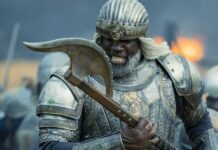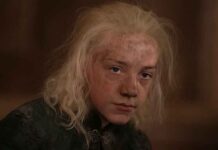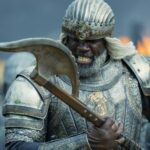During filming of the first season of “Game of Thrones,” storms destroyed sets. Endless rain delayed shooting. There was not enough money to realize the filmmakers’ vision.
As a result, those behind the show were constantly left to cut pages and scenes from the scripts in the interest of saving time and money.
When the rough cuts of episodes were assembled, the producers found they had a major problem. Some of the installments were far too short, with episodes three, four and five clocking in at just a half hour, instead of a full 60 minutes.
To fill the holes, the writers created scenes using existing actors and sets that would be quick and inexpensive to shoot.
The result? Long scenes of two characters talking, such as Robert Baratheon and Cersei Lannister’s six-minute discussion of their decaying marriage in episode five.
“I felt something for you once, you know,” the queen tells her king.
If those limitations hadn’t happened, “I don’t think we would have had as rich and successful a show,” one of the show’s masterminds, Bryan Cogman, says in the new book “Fire Cannot Kill a Dragon: Game of Thrones and the Official Untold Story of the Epic Series” (Dutton) by James Hibberd, out Tuesday.
The series was always about more than just dragons. Adapted from author George R. R. Martin’s sprawling (and as yet unfinished) series, “Game of Thrones” was a compelling human drama, featuring dozens of memorable characters struggling with a variety of fraught interpersonal and familial relationships — as well as violently trying to consolidate power.
“The biggest show of the 21st century was a massive undertaking, and it changed television forever,” Hibberd told The Post.
Martin has often said he thought his books would be impossible to adapt to the screen, and early on, that prediction seemed true. Producers hoping to option his books alienated Martin with pitches that truncated the story to focus only on Jon Snow, or suggested a movie series that might never see completion.
Writing partners David Benioff and Dan Weiss secured Martin’s trust by displaying encyclopedic knowledge of the books, including correctly deducing who Jon Snow’s mother was — a crucial plot point that had not yet been revealed.
Martin insisted that the show air on a subscription network so that the sex and violence wouldn’t have to be toned down. Benioff and Weiss ultimately found a partner in HBO.
HBO was skeptical that they could afford to produce the series, but Benioff and Weiss lied, telling them the show would be a “contained” character-driven drama.
“We knew most of the people making the decisions were not going to read four thousand pages [of Martin’s books] and get to the dragons getting bigger and the [major battles],” Weiss says in the book.
Coincidentally, HBO’s programming president Michael Lombardo happened to go to the same gym as Weiss, and one day, spotted the writer on the treadmill reading a dog-eared copy of one of Martin’s books. Lombardo liked his commitment and became determined to “figure this thing out.”
A pilot was greenlighted and the team set about casting the parts.
“This is another example of challenges resulting in a better show,” Hibberd says. “If they had had a lot of money they would have done what most shows do, which is to get famous actors. Instead, they went the hard route of doing these open casting calls and going through person after person.”
Jason Momoa won the role of the barbarian Khal Drogo by performing an intimidating Maori-warrior “haka” dance during his audition.
Maisie Williams, 12 at the time, landed the role of Arya Stark after recording an audition tape during her lunch break at school.
Sophie Turner, then 13, wasn’t even allowed to read the entirety of Martin’s books because of the “explicit stuff.” She instead stuck to just the chapters written from her character Sansa’s point of view.
John Bradley was running late for his audition, and so he happened to show up nervous and out of breath — a perfect depiction, the producers thought, of Samwell Tarly.
To play Daenerys Targaryen, the producers selected Tamzin Merchant, a then-22-year-old Brit who’d appeared in 2005’s “Pride & Prejudice.”
The pilot began shooting in October 2009. Northern Ireland was chosen because of its tax rebates and medieval filming locations.
Benioff and Weiss had no experience handling such a giant production and have admitted their inexperience led to some early mistakes. For example, to portray the zombie-like White Walker, they put an actor in a green suit, figuring the character could be created later with effects, not realizing that tactic was prohibitively expensive compared to just dressing someone in a costume.
It was a bit of a comedown, and you have to accept that it wasn’t to be.
– Lena Headey, on the disappointing death of her character, Cersei
The pilot turned out to be a disaster. Test audiences were bored and the show lacked the grand scale that would come to define it.
HBO considered pulling the plug, but Benioff and Weiss “owned” their mistakes and sold the network on a plan to fix what was wrong. HBO relented, ordering a re-shot pilot and nine more episodes.
One major change was that Daenerys Targaryen was recast. The producers have been tight-lipped about what wasn’t working with Merchant. Everyone agrees the actor did good work and was pleasant, but the performance seemed to lack some alchemical spark — mostly when it came to her scenes with Khal Drogo.
“[Merchant’s] scenes with Jason just didn’t work,” Lombardo says in the book.
Originally, name actors, including Imogen Poots, were considered to step in, but the producers instead held open auditions.
Recent drama-school grad Emilia Clarke was one of those who tried out. The producers evidently liked the strength she radiated (something she credits her mom for giving her). During her final audition, they asked Clarke if she could do “anything else,” and the actor broke out dancing the Funky Chicken. As she was walking out, she was told she had the part.
Massive new sets were created, including the Red Keep with its Iron Throne, while the brand-new-looking costumes from the original pilot were scrapped and replaced with clothes that appeared aged, dirty and sweat-stained. (“It was so great not to be wearing a costume with Velcro,” says Peter Dinklage, who plays Tyrion Lannister.)
It didn’t take long for the producers to realize the new formula was working. Martin was also pleased. The first finished scene he saw was an intimate chat between Arya and her father, Ned Stark (played by Sean Bean), in which he assures her she’ll one day marry a lord and have children. Arya responds, “No, that’s not me.”
“It was my book come to life,” Martin says.
The show premiered April 17, 2011, with a modest 2.2 million viewers. The second week, the ratings stayed level. Martin had lunch with HBO’s CEO Richard Plepler and was surprised when Plepler told him, “The show is going to last for ten years.” Usually, ratings go down for episode two. Plepler predicted the ratings would continue to go up, and he was right.
One element that kept viewers coming back were the shocking plot twists. At the end of the first season, Ned Stark, whom most viewers had assumed was the series’ central protagonist, was executed.
Martin says he was inspired by how “The Lord of the Rings” killed off wizard Gandalf. “If Gandalf could die,” he says, “anybody could die.”
Season three’s “Red Wedding,” in which Stark heir Robb (Richard Madden) and his mother Catelyn (Michelle Fairley), are massacred in an ambush, left the cast so drained that Fairley could barely talk to anyone for a week.
New faces joined the sprawling cast each season, including Dame Diana Rigg, who played Lady Olenna Tyrell starting in Season 3. The vaunted actor did things her own way. She would appear on the set and demand that filming begin, despite the crew not being ready.
“And she just started doing her lines,” says Jessica Henwick, who played Nymeria Sand. “She did two takes and. . . .she just stood up and went, ‘I’m done!’ ”
By Season 4, “Game of Thrones” had become HBO’s most popular show in history, with some 20 million tuning in each week.
The writers had often worried that their story would run out of material already published in Martin’s literary series. By season five, the TV show was indeed moving into uncharted territory.
Benioff and Weiss spent three days with Martin talking about what the author ultimately had planned for these characters, in order to sketch out the final seasons.
The showrunners calculated that the show would conclude after its eighth season, which began airing in spring 2019.
After nearly ten years, the final fate of these characters was revealed — not always in a way that satisfied the heavily invested audience.
One somewhat controversial twist was to have Arya defeat the zombie lord, the Night King. Benioff and Weiss ruled out the most obvious suspect, Jon Snow, because they were tired of him “always saving the day.” They also considered the Hound (Rory McCann), but wanted to save him for the anticipated showdown with his brother, the Mountain (Hafþór Júlíus Björnsson).
Another left turn was to have Daenerys morph into a genocidal madwoman, necessitating her murder by her lover, Jon Snow.
The showrunners insist that the seeds of Daenerys’ heel turn had been planted since season one, but many viewers felt blindsided. Even Clarke, upon reading the script, wasn’t sure how viewers would take the twist.
Another letdown for many viewers was the fate of Cersei. Fans had been anticipating a big showdown between the evil queen and Arya, who’d sworn to kill her. Instead, Cersei perished quietly when the Red Keep collapsed.
“It was a bit of a comedown, and you have to accept that it wasn’t to be,” says Lena Headey, who played Cersei.
And then there was the central question of the series: Who would end up on the Iron Throne? Benioff and Weiss argued that the choice had to be someone who wouldn’t be corrupted by power (the show’s theme).
Bran Stark (Isaac Hempstead Wright), who had transformed into the omnipotent Three-Eyed Raven, was the logical choice to them. Though when the actor received the script, he thought it was a joke and that everyone in the show had gotten a personalized script in which their character ascends to the throne.
“[Bran had transformed into the] Three-Eyed Raven, and to what end?” Benioff asks in the book. “If that didn’t lead to something incredibly consequential, it would feel anticlimactic.”
Hibberd says the series’ final episodes might get a reappraisal one day.
“The impression I get is that for some [who worked on the show], there’s a sense of thinking about the ending of ‘The Sopranos,’ about how divisive that was,” he says. “Now ten years later, it’s a more respected ending.”
Anyone who feels disappointed by the TV series’ ending still has Martin’s books to look forward to.
“When I finish my books, people can argue which is right, which is wrong, and which is the ‘real story,’ ” the author says. “None are the real story. These are fictional characters. Which one resonates with you more?”




















![[Book Review] The Blade Itself (The First Law Trilogy) by Joe Abercrombie](https://bendthekneegot.com/wp-content/uploads/2018/01/1516047103_maxresdefault-218x150.jpg)
















